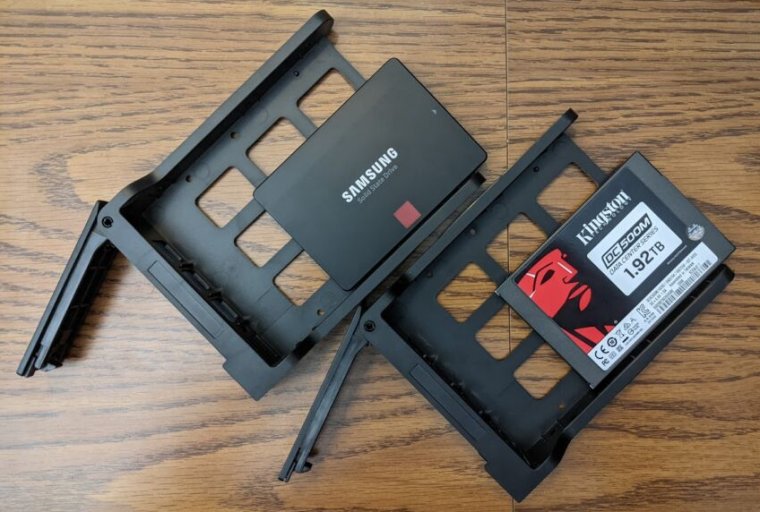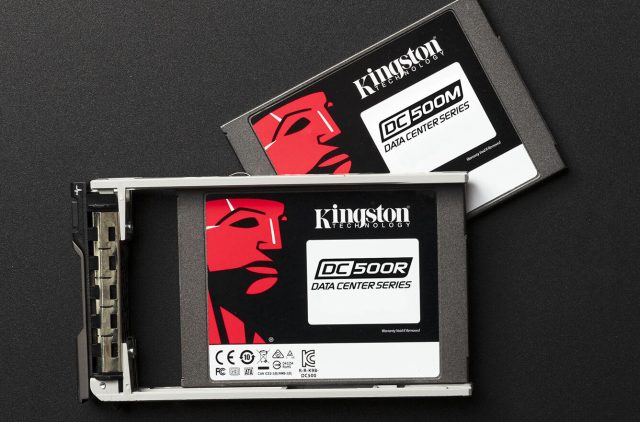

High-end SATA SSD shootout: Samsung 860 Pro vs. Kingston DC500M
source link: https://arstechnica.com/gadgets/2020/12/high-end-sata-ssd-shootout-samsung-860-pro-vs-kingston-dc500m/
Go to the source link to view the article. You can view the picture content, updated content and better typesetting reading experience. If the link is broken, please click the button below to view the snapshot at that time.

Today, we're going to put to good use some of what we covered last year in our Storage Fundamentals series—specifically, we'll use
fio to test two competing high-end SATA SSDs.
Each disk has its high points and its low points, and we'll cover both in detail as well as giving you some handy charts to compare the two directly.
Samsung 860 Pro 1TB
Samsung's 860 Pro is a staple of the prosumer industry. The 860 Pro marries raw, screaming performance to solid firmware and high write endurance while remaining accessible for consumers and small businesses. I've personally deployed hundreds of the 840 Pro, 850 Pro, and 860 Pro series of drives to good effect and with no complaints—which is more than I can say for quite a few of Samsung's competitors.
The 860 Pro is a little more expensive than its kid brother, the 860 EVO. That's because the EVO is cheaper—and the specifications Samsung chooses to publish make it look as fast—or faster. The reality can be different, depending on your use case. The EVO is a TLC drive with a fast MLC cache, while the Pro is entirely MLC.
For lightweight consumer workloads that don't burn through the EVO's MLC cache, the EVO really can be as fast as the Pro. But heavy, sustained write workloads will fall off a cliff—which is literally what the performance-over-time graphs look like—once they've filled the cache and have to fall back to writing directly to the EVO's slower TLC main media.
By contrast, the Pro performs reliably and sustainably under massive write workloads for as long as you need it to—the entire drive is fast, so there's no cliff to fall from. The Pro also has much higher write endurance, and for the same reason. The TLC-based 860 EVO 1TB is rated for 600TBW (TeraBytes Written), whereas the 860 Pro 1TB we're testing today is rated for 1,200TBW.
The 1TB 860 Pro we're testing today is available on Amazon for $200 with Prime shipping. (The 2TB version—more comparable in size to the 1.92TB Kingston—runs for $360.)
Kingston DC500M 1.92TB
The Kingston DC500M is something that mere consumers—or even "prosumers"—haven't traditionally gotten to play with very often. Unlike the Samsung, the DC500M is a true data center-grade drive, featuring power-loss protection (PLP) and serious quality of service (QoS) that helps the DC500M ensure fairness between tons of processes trying to access the drive at the same time.
The Kingston is also rated for even higher write endurance than the Samsung 860 Pro. Kingston designs the DC500M series for 0.5 Drive Writes Per Day (DWPD). The 960GB version of the DC500M is therefore rated for a whopping 2278TBW, and the 1.92TB version we're testing today is rated for 4555TBW—nearly double the endurance of the Samsung drives.
AdvertisementFor some reason, all of Kingston's data center drives on Amazon are listed in Italian—despite being sold by a wide variety of American vendors. One of the larger vendors there offers the 1.92TB DC500M for $347 with Prime shipping. If the Italian-language descriptions bother you, you can buy the drive at Newegg instead—we also found it listed by a reputable vendor there for the same $347 price.
Raw performance
-
4K random read is a painful workload for all drives—even SSDs. Both of these SATA SSDs do well on this workload, though the Samsung is significantly quicker.
-
4K random writes appear to be faster than reads—but that's because the OS is allowed to reorder them and commit them in large batches.
-
1MiB random reads are a cakewalk for any drive—even decent rust can pull 180+ MiB/sec on this test. As usual, the Samsung Pro outruns the Kingston here.
-
As usual, the Samsung Pro runs away laughing from the Kingston DC500M on 1MiB random write—another of the easiest workloads for any drive, whether solid state or rust.
I'm not going to beat around the bush—when it comes to raw performance on simple workloads, the Samsung Pro is a faster drive than the Kingston, and there aren't any two ways about it. In almost every throughput test I threw at the pair, the Samsung 860 Pro ran about 50 to 75 percent faster than the DC500M did.
The difference between the two was most pronounced where, in my experience, it tends to matter the least—the 1MiB random read and write tests. While you get the biggest raw numbers on these tests, there aren't many applications where you'll really feel the difference between 224MiB/sec and 393MiB/sec. For fairly standard workloads, the most visible place for this difference is in simple file copies from one drive to another.
Assuming the other drive can keep up with whichever of these you're using, copying several GiB of data at 393MiB/sec will obviously complete a lot faster than copying the same data at 224MiB/sec. Most applications aren't moving that much data that quickly, though—for most users, there isn't much of a seat-of-the pants difference to be seen here.
The differences between the drives at smaller blocksizes are less pronounced, but they're still there—and 4KiB random access is where the pain lives. For all I just got done telling you that most users won't really feel the difference between a 224MiB/sec read and a 393MiB/sec read on the high end, those same users will feel the difference between 26MiB/sec and 36MiB/sec on the low end.
For that reason, I'll finish this section up the same way I started it—the Samsung Pro is a much faster drive, period... for relatively simple asynchronous workloads, at least.
Data center features
-
Kingston wanted me to know how good the DC500M's QoS was—fio certainly bore out their claims.
-
The DC500M features PowerLoss Protection (PLP)—a capacitor that can power the drive long enough to commit sync writes in a queue. This allows it to acknowledge sync() requests much faster than consumer drives can.
-
The Kingston DC500M features QoS that makes it much more predictable than the Samsung 860 Pro—but the Samsung is quicker, if you don't mind the inconsistency.
The first graph in the gallery above demonstrates latency, not throughput—and it demonstrates one of the DC500M's best features to obvious effect. In that test, we ran 16 simultaneous processes, all clamoring to do 4KiB random writes as fast as they can. The y-axis here is the time to complete each 4KiB write in milliseconds, and the x-axis is the percentile each write falls into.
AdvertisementThe DC500M offers significantly better write latency than the 860 Pro, even all the way at the left end of the chart—the fastest 1 percent of all 4K writes complete in 775 microseconds on the Samsung, versus only 375 microseconds on the Kingston. But the real story doesn't happen until around the 30th percentile, where the 860 Pro's latencies start increasing dramatically—but the DC500M's latencies do not.
At the 50th percentile—otherwise known as the median latency—we're looking at 36 milliseconds for the Samsung, versus only 0.5 milliseconds for the Kingston. By the 95th percentile, the Samsung is taking 52ms to complete a write, while the Kingston is still finishing in a mere two milliseconds. The great QoS we're seeing here might not matter much on a desktop, but it's a killer feature for heavily loaded database servers or VM hosts.
The second chart shows synchronous 4K writes. This is what you get when an application calls sync()—which basically tells the computer "I'm not doing anything else until you confirm you've written that out safely to disk." The Kingston DC500M has power-loss protection—thanks to power capacitors onboard, it can safely write out any pending blocks in its DRAM cache, even without any power from the system it's in.
The Samsung 860 Pro does not have PLP and therefore can't guarantee the safety of blocks in its DRAM cache—so sync writes must actually get all the way to the metal before the sync() call can return. That means the Samsung ends up with less than a 10th the sync throughput of the truly data center-grade DC500M.
Finally, the third chart offers us a different look at the same 16-process 4KiB async write we charted the latency on in the first graph. The Samsung is still a faster drive, in terms of sheer, sustained throughput—but the DC500M's much lower and more predictable latency goes a long way toward demonstrating that high throughput isn't always the same thing as seat-of-the-pants "fast."
Conclusions
It probably shouldn't come as much of a surprise that the much more consumer-oriented Samsung 860 Pro is likely the best choice for most consumers. What might come as a surprise to many Ars readers is just how affordable a true data center SSD—like the DC500M—can be, even when bought in single units.
For a standard desktop-and-gaming workload, it's hard to say which of these two drives would "feel" faster. The Kingston drive will return much faster from the most latency-sensitive tasks than the Samsung will—but the Samsung has considerably higher raw throughput.
Similarly, the Kingston offers double the write endurance of the Pro—but most desktop users won't really need it. With that said, the write endurance disparity can become more important in the latter years of a drive's life—performance tends to slope downward as an SSD ages, even when still well within its rated endurance.
The throughput difference between a DC500M and an 860 Pro at a few hundred TBW may be considerably smaller than the one you see here, when the drives are in brand-new condition—and the disparity would almost certainly disappear entirely or even reverse itself, as each drive approaches a full petabyte written.
If you're building a desktop or gaming PC, you can't really go wrong with either of these drives—but we'd generally give the 860 Pro the nod for its massive throughput. By the time the DC500M's much higher write endurance becomes a factor in a standard PC, the entire system should hopefully have aged out and been replaced long since.
But if you're building a big server running heavily loaded databases—or lots of VMs—the DC500M's data center-grade features, including power-loss protection, massive write endurance, and excellent QoS, are worth serious consideration, despite the Samsung's throughput advantage.
Recommend
About Joyk
Aggregate valuable and interesting links.
Joyk means Joy of geeK

